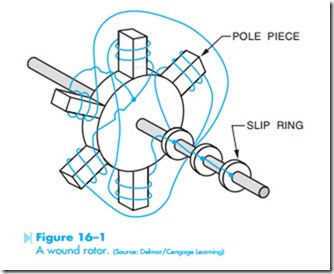The Wound Rotor Induction Motor
Another type of three-phase induction motor used for operating large air conditioning units is the wound rotor induction motor. The stator winding of this motor is the same as the stator of a squirrel-cage induction motor. The rotor of the wound rotor motor, however, does not contain squirrel-cage bars. The rotor of this motor contains wound coils of wire as illustrated in Figure 16–1. The rotor will contain as many poles as there are stator poles. The motor shown in Figure 16–1 would be for a two-pole stator. Notice that there are three separate windings on the rotor. The finish end of each winding is connected together. This forms a wye connection for the rotor winding. The start end of each winding is connected to a separate slip ring on the rotor shaft.
The slip rings permit the connection of external resistance to the rotor windings. Figure 16–2 shows
a schematic diagram of the stator connection and rotor connection of a wound rotor motor. Notice that the wye-connected stator winding is connected directly to the incoming power. The wye-connected rotor is connected to three variable resistors. The dashed line drawn between the resistors indicates that they are mechanically connected together. If the resistance of one is changed, the resistance of the other two changes also.
Resistance is connected to the slip rings by means of carbon brushes as shown in Figure 16–3. Because the resistance connection to the rotor is external, the amount of resistance used in the circuit can be controlled. This permits the amount of current flow in the rotor to be controlled. If the current flow in the rotor is limited by the amount of resistance connected in the circuit, the stator current is limited also. A great advantage of the wound rotor motor is that it limits the amount of inrush current when the motor is first started. This eliminates the need for reduced voltage starters or wye-delta starting.
Another advantage of the wound rotor motor is its high starting torque. Because resistors are used to limit current flow in the rotor, the phase angle between the stator current and the rotor current is close to 90°. The schematic symbol for a wound rotor motor is shown in Figure 16–4.
